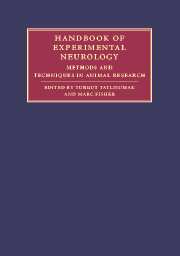Book contents
- Frontmatter
- Contents
- List of contributors
- Part I Principles and general methods
- Part II Experimental models of major neurological diseases
- 18 Focal brain ischemia models in rodents
- 19 Rodent models of global cerebral ischemia
- 20 Rodent models of hemorrhagic stroke
- 21 In vivo models of traumatic brain injury
- 22 Experimental models for the study of CNS tumors
- 23 Experimental models for demyelinating diseases
- 24 Animal models of Parkinson's disease
- 25 Animal models of epilepsy
- 26 Experimental models of hydrocephalus
- 27 Rodent models of experimental bacterial infections in the CNS
- 28 Experimental models of motor neuron disease/amyotrophic lateral sclerosis
- 29 Animal models for sleep disorders
- 30 Experimental models of muscle diseases
- Index
- References
25 - Animal models of epilepsy
Published online by Cambridge University Press: 04 November 2009
- Frontmatter
- Contents
- List of contributors
- Part I Principles and general methods
- Part II Experimental models of major neurological diseases
- 18 Focal brain ischemia models in rodents
- 19 Rodent models of global cerebral ischemia
- 20 Rodent models of hemorrhagic stroke
- 21 In vivo models of traumatic brain injury
- 22 Experimental models for the study of CNS tumors
- 23 Experimental models for demyelinating diseases
- 24 Animal models of Parkinson's disease
- 25 Animal models of epilepsy
- 26 Experimental models of hydrocephalus
- 27 Rodent models of experimental bacterial infections in the CNS
- 28 Experimental models of motor neuron disease/amyotrophic lateral sclerosis
- 29 Animal models for sleep disorders
- 30 Experimental models of muscle diseases
- Index
- References
Summary
Introduction
Epilepsy is a common disorder of the brain affecting approximately 1–3% of people worldwide. Clinically, the epilepsies are characterized by spontaneous, recurrent epileptic seizures, either convulsive or non-convulsive, which are caused by partial or generalized discharges in the brain. Important advances have been made in the diagnosis and treatment of seizures disorders. Although many antiepileptic drugs (AEDs) have been introduced, approximately 30% of patients remain pharmacoresistant.
Animal models of seizures and epilepsy have played a fundamental role in the understanding of the physiological and behavioral changes associated with human epilepsy. They allow us to determine the nature of injuries that might contribute to the development of epilepsy, to observe and intercede in the disease process subsequent to an injury preceding the onset of spontaneous seizures, and also to study the chronically epileptic brain in detail, using physiological, pharmacological, molecular, and anatomical techniques.
Some criteria for a good animal model should be satisfied before the model could be considered useful for a particular human seizure or epilepsy condition. As the pattern of electroencephalograph (EEG) activity is a hallmark of seizures and epilepsy, the animal model should exhibit similar electrophysiological patterns to those observed in the human condition. The animal model should display similar pathological changes to those found in humans, it should respond to AEDs with similar mechanisms of action, and behavioral characteristics should in some way reflect the behavioral manifestations observed in humans. This chapter briefly reviews those models that most closely approximate human epilepsy.
- Type
- Chapter
- Information
- Handbook of Experimental NeurologyMethods and Techniques in Animal Research, pp. 438 - 456Publisher: Cambridge University PressPrint publication year: 2006



